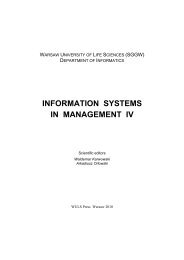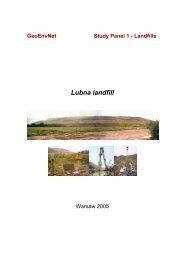126 J. WiśniewskaTable 3. An attempt to determine the main goals and results of sustainable agriculture inenvironmental, economic, social and institutional scopeTabela 3. Próba określenia podstawowych celów i rezultatów zrównoważonego rolnictwaw wymiarze środowiskowego, ekonomicznego, społecznego i instytucjonalnegoGoal Environmental Economic Social Institutional• Quality of NaturalResources• Ecological Effectiveness• Ecological Innovativeness• Reduction of Ecosystem Tensions• Reduction of Environmental Degradation Effects onPeople’s Lives• Optimisation ofExpenditure Use• Increasein Productivity• Competitive FarmingSector• Economic Efficiencyof Farms• Economic Efficiencyof Ecological Farms• Optimal Inter--Generational Allocation of Resources• Ensuring SuppliesNecessary to EnsureFood Safety of ThePopulation• Ensuring Jobs• The Degree of Satisfying Needs• Optimal Allocationof Public Goods& Services• Low TransactionCosts• Development of Economic Infrastructure• Effectiveness ofManaging NaturalEnvironment• Internalisationof External Costs;Result Environmental Economic Social Institutional• Implementing Eco--DevelopmentProgrammes• Participation in Ecological Initiatives• The Division ofProfits & LossesFrom EcologicalInitiatives• Creativity of ThePrivate Sector;• MaximisingAggregated Wealth• Effective Distributionof Income• Perfect Competition• Just Division ofProfits & Losses• Human CapitalDevelopment• Distribution ofIncomes• Living Standardof Farmers• Percentage of Population Under PovertyLine• Equal Opportunitiesfor Farmers& Non-Farmers• Unemployment Rate• Demographic Development• Access to Education• Development ofSocial Infrastructure• Universality& InstitutionalTransparency• Common AccessTo Public Goods& Services• Access to Information• Efficient System ofIntervention• InternationalCooperationSource: Authoress’ own compilation on the basis of: [A Framework… 2001, Directions... 1999].Źródło: Opracowanie własne na podstawie: [A Framework… 2001, Directions... 1999].adaptation, technical and technological progress, efficiency and effectiveness ofproduction and sales, price competitiveness, high quality of products and services, highincome, developmental investments and R&D inputs. The environmental functionsof sustainable agriculture include: protecting earth’s natural resources, protecting thesanitary conditions of food articles, protecting and developing natural environment,including water, soil and air [Directions... 1999]. Important sustainability areas havebeen defined as regards agriculture, i.e. economic, social and environmental areas,with regard to which the level of economic effectiveness and social justice havebeen defined as sustainability measures. Basically, the conception of sustainabilityconcerns such categories as: preserving and protecting resources, the effectiveness oftransformation processes and intergenerational equilibrium [A framework... 2001]. Thesocial functions agriculture include being a source of households’ incomes, a placefor professional activity, cultural development and cultivation of national tradition,leisure and recreation, promotion of tourism and healthy lifestyle and ensuring foodsafety. As well as in the overall sustainable economy, it is impossible not to considerActa Sci. Pol.
Economic sustainability of agriculture – conceptions and indicators 127the institutional approach in the contemporary notion of sustainable agriculture either[Zegar 2005].To sum up, the conception of sustainable agriculture marks a multi-layer range ofgrowth, taking into account economic, social, ecological and institutional aspects. Theaims of sustainable development in national economy are marked by three areas of interaction:social welfare, social justice and respect for natural environment. In order to implementthe rules of sustainable development, farms, like non-farming enterprises, cannotsolely act basing on the profit criterion, but they also have to take into account ecologicalcriteria and, first of all, social criteria. The contemporary policies of sustainable developmentof rural areas are determined according to the conception of sustainable agriculture.Therefore, a question arises how to measure the effects of the implemented activitiesaimed at an integral development of rural areas, especially those immeasurable ones andunquantifiable ones.ECONOMIC SUSTAINABILITY OF AGRICULTUREIn the macroeconomic debate, a few economic sustainability criteria are mentioned,like: rate of growth of production and income, effectiveness, efficiency, innovativeness,competitiveness, public debt. While criteria like inflation, unemployment rate, tradeimbalances are politically prominent, but hardly ever located in sustainability context.Other, traditional criteria like aggregated demand, consumption levels and savings ratesplay a minor role in the current debate. So whereas there are ideas to be found in the economicsliterature regarding the environmental, social and sometimes institutional sustainabilityof the economic system, there is hardly any information available on the economicsustainability of the economy (and thus not on the overall sustainability of the economy,which comprises all four components). Even less so, criteria of economic sustainabilityhave been developed for the other dimensions [Spangenberg 2005].The parameterisation of sustainable agriculture achievements is considerably moredifficult than that of conventional agriculture, as the latter generally aims at intensificationand the basic economic criterion allows to quantify the effects with regard to agiven value, i.e. efficiency, profit or profitability and to provide their absolute magnitudes[Baum 2003]. Much recent work on measuring progress towards sustainable developmenthas addressed specific issues, such as measuring climate change or the environmentaland social impacts of particular sectors (e.g. agriculture, energy and transport). Measuringsustainable development at an aggregate level, however, requires a broad integrationof indicators of economic, environmental, and social changes. One way to achieve thisintegration is to extend the traditional framework used for measuring economic activity– the National Accounts. Extensions of the National Accounts to the environmental areacurrently underway. These extensions are aimed at recording changes in environmentalassets, and at highlighting environment-related transactions (e.g. pollution abatement andcontrol expenditure). Extensions to the social area may also allow the linking of accountsmeasuring employment, human capital, and the distribution of household income andconsumption among various socio-economic groups. Measuring natural and human capitalrequires both monetary and physical data. While work in these fields has progressed,Oeconomia 10 (1) 2011
- Page 6 and 7:
6 A. Gawrońska, S. Paszkowskicultu
- Page 8 and 9:
8 A. Gawrońska, S. Paszkowskinumbe
- Page 10 and 11:
10 A. Gawrońska, S. PaszkowskiTabl
- Page 12:
12 A. Gawrońska, S. PaszkowskiTabl
- Page 15 and 16:
The distribution of social security
- Page 17 and 18:
%180,0160,0140,0120,0100,080,060,04
- Page 19:
The distribution of social security
- Page 22 and 23:
22 R. Hryniewski, W. Mądry, D. Goz
- Page 24 and 25:
24 R. Hryniewski, W. Mądry, D. Goz
- Page 26 and 27:
26 R. Hryniewski, W. Mądry, D. Goz
- Page 28 and 29:
28 R. Hryniewski, W. Mądry, D. Goz
- Page 30 and 31:
30 R. Hryniewski, W. Mądry, D. Goz
- Page 32 and 33:
32 R. Hryniewski, W. Mądry, D. Goz
- Page 35 and 36:
Oeconomia 10 (1) 2011, 35-43EDUCATI
- Page 37 and 38:
Education as an element of competit
- Page 39 and 40:
Education as an element of competit
- Page 41 and 42:
Education as an element of competit
- Page 43:
Education as an element of competit
- Page 46 and 47:
46 E. Majewski, P. Sulewski, M. Rag
- Page 48 and 49:
48 E. Majewski, P. Sulewski, M. Rag
- Page 50 and 51:
50 E. Majewski, P. Sulewski, M. Rag
- Page 52 and 53:
52 E. Majewski, P. Sulewski, M. Rag
- Page 54 and 55:
54 E. Majewski, P. Sulewski, M. Rag
- Page 56 and 57:
56 E. Majewski, P. Sulewski, M. Rag
- Page 58 and 59:
58 L. Mazal, K.J. RowlesIn the West
- Page 60 and 61:
60 L. Mazal, K.J. RowlesThe most im
- Page 62 and 63:
62 L. Mazal, K.J. RowlesGDPt= GDP0+
- Page 64 and 65:
64 L. Mazal, K.J. RowlesTHE TIME SE
- Page 66 and 67:
66 L. Mazal, K.J. RowlesTable 4. Ac
- Page 68 and 69:
68 L. Mazal, K.J. RowlesNelson Ch.R
- Page 70 and 71:
70 A. Ptak-Chmielewskastatistics, w
- Page 72 and 73:
72 A. Ptak-Chmielewska3025birth rat
- Page 74 and 75:
74 A. Ptak-ChmielewskaSECTOR OF ACT
- Page 76 and 77: 76 A. Ptak-Chmielewskabirth rate fo
- Page 78 and 79: 78 A. Ptak-Chmielewskawere trade fi
- Page 80 and 81: 80 A. Ptak-ChmielewskaREFERENCESBal
- Page 83 and 84: Oeconomia 10 (1) 2011, 83-95THE EFF
- Page 85 and 86: The effi ciency of selected real es
- Page 87 and 88: The effi ciency of selected real es
- Page 89 and 90: Table 1. Efficiency of real estate
- Page 91 and 92: The effi ciency of selected real es
- Page 93 and 94: The effi ciency of selected real es
- Page 95: The effi ciency of selected real es
- Page 98 and 99: 98 J. Sosnowski, G.A. CiepielaJalin
- Page 100 and 101: 100 J. Sosnowski, G.A. Ciepiela2007
- Page 102 and 103: 102 J. Sosnowski, G.A. CiepielaTabl
- Page 104 and 105: 104 J. Sosnowski, G.A. CiepielaTabl
- Page 106 and 107: 106 J. Sosnowski, G.A. Ciepiela1400
- Page 108 and 109: 108 J. Sosnowski, G.A. CiepielaOsek
- Page 110 and 111: 110 E. SzymańskaProducts by Activi
- Page 112 and 113: 112 E. Szymańskatroduced TFI which
- Page 114 and 115: 114 E. Szymańskabers of companies
- Page 116 and 117: 116 E. SzymańskaTable 3. Tourism v
- Page 118 and 119: 118 E. SzymańskaREFERENCESCoccossi
- Page 120 and 121: 120 J. WiśniewskaEvery society can
- Page 122 and 123: 122 J. WiśniewskaStatistical analy
- Page 124 and 125: 124 J. WiśniewskaCommon Agricultur
- Page 128 and 129: 128 J. Wiśniewskathe application o
- Page 130 and 131: 130 J. Wiśniewskainstitutional cos
- Page 132 and 133: 132 J. Wiśniewskaemployed in agric
- Page 134 and 135: 134 J. WiśniewskaLong term viabili
- Page 136 and 137: 136 J. Wiśniewska--The level of re
- Page 139 and 140: Oeconomia 10 (1) 2011, 139-148INNOV
- Page 141 and 142: Innovativeness of food production e
- Page 143 and 144: Innovativeness of food production e
- Page 145 and 146: Innovativeness of food production e
- Page 147 and 148: Innovativeness of food production e
- Page 149 and 150: Oeconomia 10 (1) 2011, 149-158LOCAL
- Page 151 and 152: Local governance activities in supp
- Page 153 and 154: Local governance activities in supp
- Page 155 and 156: Local governance activities in supp
- Page 157 and 158: Local governance activities in supp
- Page 159 and 160: Oeconomia 10 (1) 2011, 159-169CHANG
- Page 161 and 162: Changes in rural women’s movement
- Page 163 and 164: Changes in rural women’s movement
- Page 165 and 166: Changes in rural women’s movement
- Page 167 and 168: Changes in rural women’s movement
- Page 169: Changes in rural women’s movement
- Page 172: Ewa SzymańskaTourism function of M
















